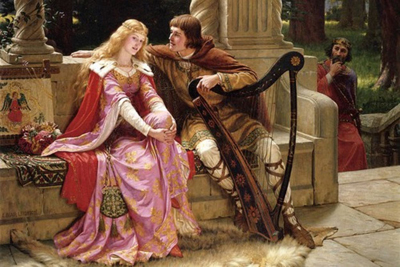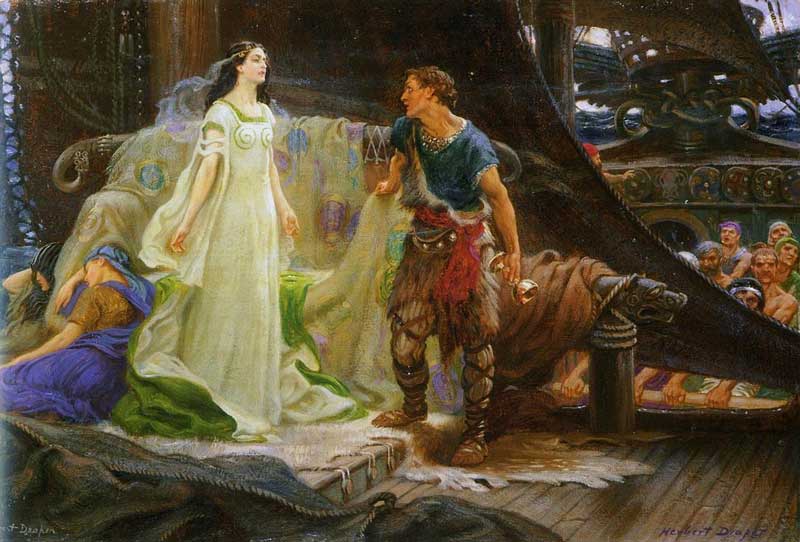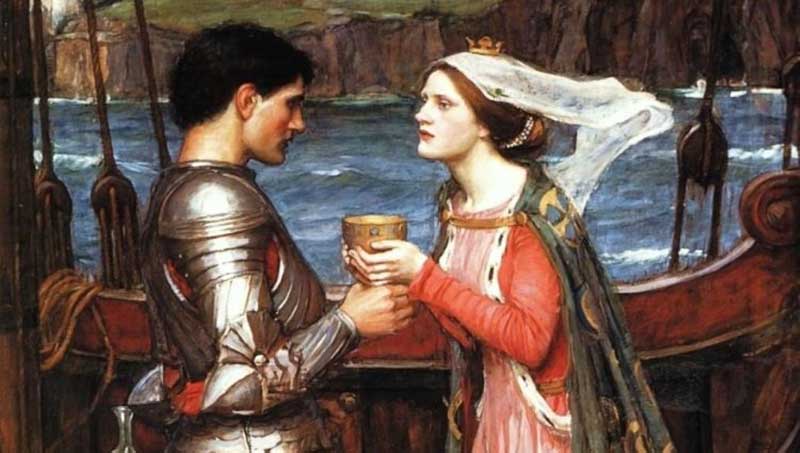
The tragic love story of Tristan and Isolde, based on a Celtic legend, is one of the famous medieval tragic-romances, retold in numerous sources with as many variations andsometimes associated with the legend of King Arthur. The legendary tale has mainly come to be known in two forms, known as the courtly branch and the common branch. While the first inspired the romances of Thomas of Britain and Béroul, two poets from the second half of the 12th century, the second is derived from The Prose Tristan (c. 1240),establishing Tristan as a Knight of the Round Table of King Arthur.
However, as both the myths have their roots in medieval Britain and or Ireland, itis not unlikely that the adulterous love between the Cornish knight Tristan and the Irish princess Isolde has had influenced the Arthurian romance of Lancelot and Guinevere. From the time the story first appeared in the 12th century, it had imparted a substantial impact on Western culture and fine arts with an enduring attraction and appeared in different forms of literature and art, like opera and drama, prose and poetry and has long since become a classic.However, although the details of the story differ from one author to another, the overall plot structure remains much the same, depicting the eternal story of conflict between good and evil, betrayal and loyalty, self-interest and selflessness.

Tristan wasthe son of Rivalen, a knight, who was killed in a battle before Tristan was born. As Tristan also lost his mother, Blancheflor, the sister of King Mark of Cornwall, at an early age, he was raised at the instruction of the king, to be a spirited young man, a proficient swordsman and also a musician, an accomplished harp-player. The king loved his nephew and made him a member of the Court of King Mark of Cornwall, as well as a knight. Nevertheless, Tristan was grateful to his uncle and also respects and loves King Mark as his mentor and adopted father.
The episode of Morholt of Ireland, a powerful Irish knight and the brother of the Queen of Ireland, is depicted in many versions of the legend, whom the Irish King used to send to collect tributes from King Mark. However, the King of Ireland agreed that the tribute would not need to be paid, if a Cornish champion could beat the Irish giant, the King’s brother-in-law, in single combat. As no knights in Cornwall ever dared to face Morholt, Tristan decided to take the challenge and three days later, the two knights met on the island of St Samson. In the fierce battle, Tristan was slightly injured, but he mortally wounded Morholt, leaving a piece of his sword in his body.Before his death,Morholt divulged to Tristan that he would also die of his wound, as Morholt had smeared his weapon with poison and only his sister, the queen of Ireland, could save him. Morholt’s men took his body to Ireland, where the queen mourned for the death of her brother and also found a small piece of Tristan’s sword fragment lodged in his body. However, her daughter, princesses Isolde, kept the splinter with her.

Meanwhile, Tristan soon realised that no physicians in Cornwall could heal his wound that gave off a pungent odour. He remembered the last words of Morholt before his death and decided to take the risk of visiting Ireland in the disguise of an imaginary musician, trying to get the queen to heal his wound. Accordingly, while he played the harp to win the heart of Isolde, who wanted to learn to play it from him, the queen healed his wound by removing the poison with herbs, unknowingly healing her brother’s killer. Tristan fully recovered from his wound in forty days, during which he fell in love with the beautiful daughter of the queen, princesses Isolde, with whom he spent many hours teaching her the art of playing the harp. However, he knew it fully well that she would never accept him as her husband if she comes to know his identity as the killer of her uncle.
Finally, he decided to leave for his country, broken hearted.
Back in Cornwall, while King Mark rejoiced the recovery of his dear nephew, three noblemen of the court, who were jealous of Tristan, apprehended that as the king is unmarried, he might select Tristan as the heir of the crown. As Tristan on his return from Ireland spoke highly about the Irish Queen and her daughter, those noblemen proposed the king marry princesses Isolde, which would be a marriage of convenience to end the bitter enmity between the two countries. As a grand way to get rid of Tristan, they also suggested sending Tristanto the Irish court with the proposal, as they hoped that he would be killed there by the infuriated men of Morholt.Finally, when King Mark resolved to marry Isolde, Tristan, for his love and loyalty, had to agree to visit Ireland and seek Isolde's hand for his uncle.

On his arrival, Tristan came to know that Ireland was being terrorized by a fearsome dragon and King Goram had promised to gift his daughter’s hand in marriage as a reward to the hero who could kill the beast. Tristan sought out the dragon’s lair and succeeded in killing the beast, but was injured in the combat. He was immediately taken to the king’ palace under the care of the queen, but while Isolde was nursing him, she discovered his broken sword and realized that he was the unidentified and unknown warrior who had killed Morholt, her uncle. Although she immediately wanted to avenge her uncle's death, Isolde restrained herself, as Tristan had saved the Irish people by killing the dragon. But when Tristan divulged his true identity and his actual reason for visiting Ireland, she vehemently rejected the idea to marry the older King Mark. However, Tristan patiently explained and convinced her mother, the queen, that if Isolde agree to marry his uncle, their son would be King of Cornwall and Ireland.
Finally, at the insistence of her mother, Isolde agreed to marry King Mark and forgave the killer of her uncle, as he was the ambassador of her would be husband, although she was not aware that the same man was the musician who taught her to play the harp. However, although Isolde agreed to the proposal of the marriage, the queen had the apprehension that her daughter would not be happy being the wife of the Cornish king, a much older man. So she prepared a magical love potion and gave the bottle containing the potion, to Brangwain, the maidservant, who is to accompany her daughter during her journey to Cornwall. She was instructed to administer the potion to the married couple on their wedding night, which would make them love each other forever. But an unimagined incident occurred during the voyage to Cornwall, when the pair wanted to have a drink and as they found the bottle containing the love potion, they drank it, believing it to be wine. The effect was spontaneous and it immediately made the pair fall for each other and they made love on board, before arriving Cornwall.

When Brangwain discovered the affair, she found no other way but to explain the backstory to the pair, requesting them to restrain themselves. The lovers believed her and realised what had happened, but could not control their passions for one another. However, no sooner than King Mark met Isolde, he instantly fell in love with her beauty and the two got married. Nevertheless, Brangien felt guilty about the mishandling of the love potion and to help her lady, she took the place of Isolde in the bed of King Mark on the wedding night, taking the advantage of darkness in the room, while Isolde spent that night in her lover’s arms and before daylight secretly returned to her husband’s bed.

The secret affair continued for days together, until three noblemen accused the two of adultery, which the king refused to believe. But when they trapped the lovers and obtained proof of their guilt, the king lost patience and was hurt and angered by their betrayal. He banished Tristan from his kingdom, but forgave Isolde for his love towards her and she was allowed to remain his wife. Tristan left Cornwall, served different kings and fought in many battles, before settling in Brittany, where he married a woman for her name, as she was also known as Isolde, Isolde of the White Hands. However, his love for Isolde of Cornwall had never died and he could never consummate his marriage to Isolde of the White Hands because of his love for the first Isolde. He was also struggling with the pain of an earlier wound, the wound of a poisoned lance, which had no cure.

Desperate to see the love of his life for the last time and knowing that only she could heal him and save his life, Tristan sends one of his followers to meet Isolde of Cornwall and inform that that he is dying and he wants to see her. Unsure about the outcome, Tristan instructed his man to hoist a white sail if the ship carried Isolde or a black sail if it did not. While Tristan lay on his sickbed and waited, Isolde readily agreed to travel to see Tristan, her true love, as she was sure that with her love she could heal his wound and save his life. As the ship with white sails appeared on the horizon, Tristan, too weak to sit up and watch, kept on asking his wife about the colour of the sails. However, when Isolde of the White Hands saw the white sails hoisted on the returning ship, signalling that Irish Isolde was on her way to see Tristan, out of jealousy of the former love of her husband, she lied and reported that the ship carried black sails. Tristan could not take it anymore, the news that his love had rejected the chance to save him, broke his heart. He gave up his fight to stay alive and died. After a while, when Isolde arrived to find her lover dead, she knelt over Tristan and wept as she knew she was only moments away from saving him. She wrapped her arms around him, collapsed on his body and died instantly in a final embrace.
The mortal bodies of the lovers were buried side by side in Cornwall. According to some versions of the story, two trees grow out of their graves with intertwined branches, signifying that they cannot be separated even in death. However, the legend of Tristan and Isolde is a very long story with lots of sub-plots and several episodes.
